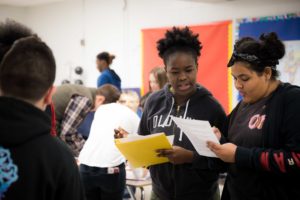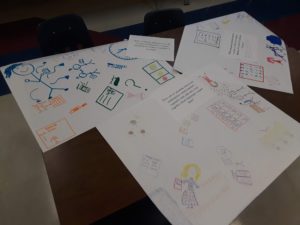 to imagine in this Covid-19 era), but stick with me for a minute. As you’re walking, you pass by several classrooms, some are noisy, some are quiet, some have kids sitting at their desk, some have kids moving about the room. Now imagine that some of those classrooms have kids talking to each other. What would you think? Would you think that learning is taking place in that classroom or that the teacher has a lack of control? I think most teachers are afraid of people thinking the latter. Especially perhaps the school principal. No teacher wants to be known as the one who lacks control. BUT, I bet you every single teacher out there wants to be known as the one whose students LEARN. So this begs the question – how do students LEARN? Well, the answer is a bit simpler than one may think. It really boils down to this: the one doing the talking, is the one doing the learning. Don’t believe me? Ask Dr. Jennifer York-Barr, author of Reflective Practice for Renewing Schools: An Action Guide for Educators or one of the many other researchers who have concluded that students need to talk in order to learn.
to imagine in this Covid-19 era), but stick with me for a minute. As you’re walking, you pass by several classrooms, some are noisy, some are quiet, some have kids sitting at their desk, some have kids moving about the room. Now imagine that some of those classrooms have kids talking to each other. What would you think? Would you think that learning is taking place in that classroom or that the teacher has a lack of control? I think most teachers are afraid of people thinking the latter. Especially perhaps the school principal. No teacher wants to be known as the one who lacks control. BUT, I bet you every single teacher out there wants to be known as the one whose students LEARN. So this begs the question – how do students LEARN? Well, the answer is a bit simpler than one may think. It really boils down to this: the one doing the talking, is the one doing the learning. Don’t believe me? Ask Dr. Jennifer York-Barr, author of Reflective Practice for Renewing Schools: An Action Guide for Educators or one of the many other researchers who have concluded that students need to talk in order to learn.
Wait. What did you say?
Oh, no. I can’t let my students talk. Nope. That’s when I lose control. So, just cross out that part.
To you I say, yes, yes, you can! I promise. You can not only let your students read, write, listen to you talk about plants or whatever content you’re currently teaching, but you can also let them SPEAK TO EACH OTHER about it. You’re right though, when you don’t have a structure in place with some accountability, student conversations can get out of hand. But still, our kids need to talk, and they need more than the simple routine of “turn-and-talk” (which, mind you, is still a great strategy and should be part of every classroom), but there are so many other ways! Let me show you one in particular.
I’d like to introduce you to my most favorite Academic Dialogue structure: Cafe’ Conversation. It’s a beautiful blend of collaboration, communication and visual art and always ends up creating a unique piece of work that captures thinking from all parties. As with any structured dialogue experience, it’s got built in accountability for your students.
Let’s walk through how this works and the how and when you could use it in your classroom.
When introducing a new strategy to your students, it’s always best to use it with low-risk content from your discipline or from life – something that all students are able to relate to and contribute thinking to. Using this at the beginning of the year would be an engaging way to switch up the “getting-to-know-each-other” conversations in your classroom.
As with any other strategy you may use in your classroom, it’s important to have a clear purpose for using it. What do you need your students to learn or get out of this activity? Is it to activate prior knowledge? Process new learning? Demonstrate understanding? These factors will be key to determining the questions you create in step 1 of this process.
Step 1: Create a list of 3-5 guiding questions that are sure to spur discussion amongst your students. These are typically focused on large concepts and ideas related to specific content. It’s important to have well-crafted questions that are open-ended, have many possible responses, invite multiple perspectives, and create a space for idea development. For example, a strong guiding question might be “What are some ways to show kindness?” or “How was character A different from character B?” This is not the time to ask tricky true/false questions. Is there ever a good time for that? Nevermind…I digress.
Step 2: Divide students into small groups with no more than 4 per group. Groups should be dispersed around the room, spaced far enough away from other groups to allow for focused conversations. Provide each group with a set of drawing utensils and one of the guiding questions developed in Step 1 written on a large piece of chart paper. If you don’t have chart paper, roll out that rack of butcher paper from the supply closet and rip off a 4’ section for each group.
Note: Be sure to give each group a different guiding question.
Step 3: Give students parameters for discussion:
Each group will get 5-10 minutes to read, discuss, and respond to their question. Using the drawing utensils provided, they should respond to their question through images only, keeping word usage to a minimum (perhaps only to label a picture). This is especially nice for those who struggle to draw stick people (no, I’m not pointing at you, Karen!). Cafe’ Conversation papers shouldn’t end up with paragraphs written all over them.
As your students are hovered over their papers, be sure to listen in on conversations and monitor student responses. This can give you great insight to what students are learning or perhaps any misconceptions they’re making about the content. Hello formative assessment!
Note: An easy way to implement some accountability at this step is to have each student draw with a different colored marker.

Step 4: After an appropriate period of time at a given station, each group should then rotate to a new guiding question (one that another group started with). Before students begin adding their own thoughts as described in Step 3, they should first read the new guiding question before them and discuss what the images from the previous group represent. Students can build upon the images left for them by the previous group, or contribute new thinking. Continue this rotation process until all groups have visited each guiding question.
Step 5: After visiting all stations, groups return to their “home base,” the station where they began. Now, here is where critical thinking goes to the next level: The group collectively creates one synthesis statement that represents all the thinking and images on their paper. Have each group share out their question and synthesis statement aloud for the class. Ask yourself, “What do I notice? Are there any key points my students missed? Or did they hit the nail on the head?” This, my friend, is how you can gauge how well they’ve grasped the content way before you grade that summative assessment.
Finally, there are a few things to consider when implementing Cafe’ Conversation in your classroom. Be mindful of timing – think about how much knowledge your students will be able to bring to the table (literally and figuratively speaking) with these questions. The more they can bring, the more time you can give. However, too much time per session may prevent new groups who rotate in from contributing any new thinking to the paper. Short time frames also help keep those conversations around weekend plans or birthday parties at bay.
Another thought: once your students become experts with Cafe’ Conversation, invite them to help you develop topics and guiding questions. It would be interesting to see what information they want to learn from each other and what’s most important to them.
That’s it! I love so many things about Cafe’ Conversation. One is that it can be used at any grade level for any content. Therefore, if you’re looking for a solid, vertical, whole-school learning strategy, this is it! Secondly, it encourages everyone to participate, even those who may feel artistically challenged or prefer to sit in the back with their hoodie pulled over their eyes. If you’re one to worry about lacking control, adjust the time in step 3, keep your questions focused, and expect some meaningful noise to take place in the process. But remember – your students NEED to have these discussions with each other to process what they’re learning. Listen to them infer, connect, and explain their thinking to their peers. You’ll be amazed at how much you learn about your students and what they know!

Student-to-student discussions don’t have to mean a lack of classroom management, but rather an intense and highly effective learning culture where everyone has opportunities to participate. Remember, the one doing the talking is the one doing the learning, so make sure it’s not always you (yes, now I’m pointing my finger at you)!
